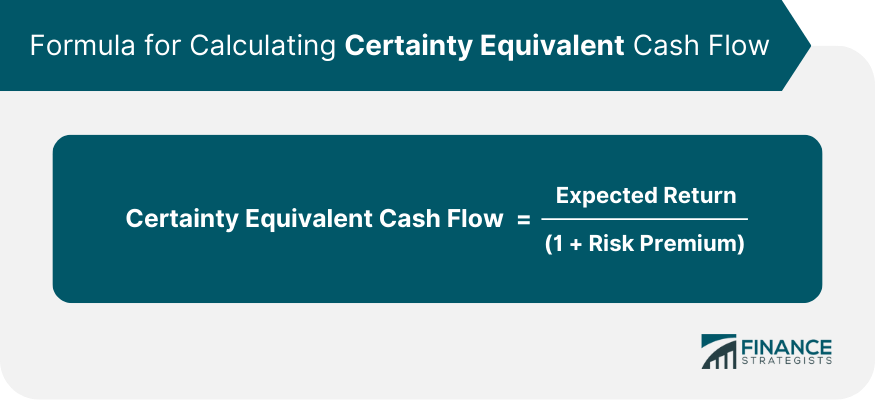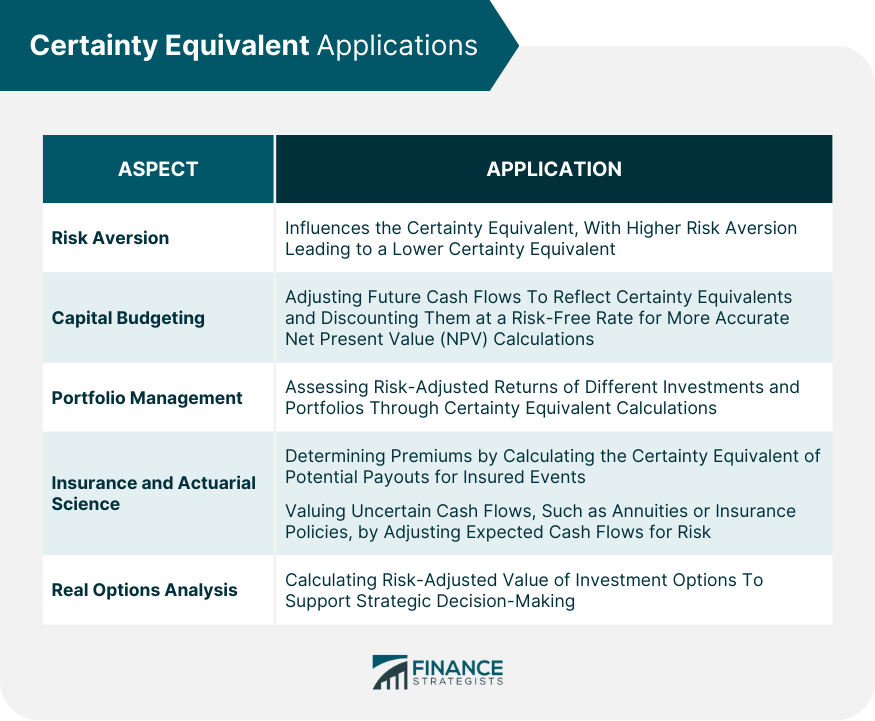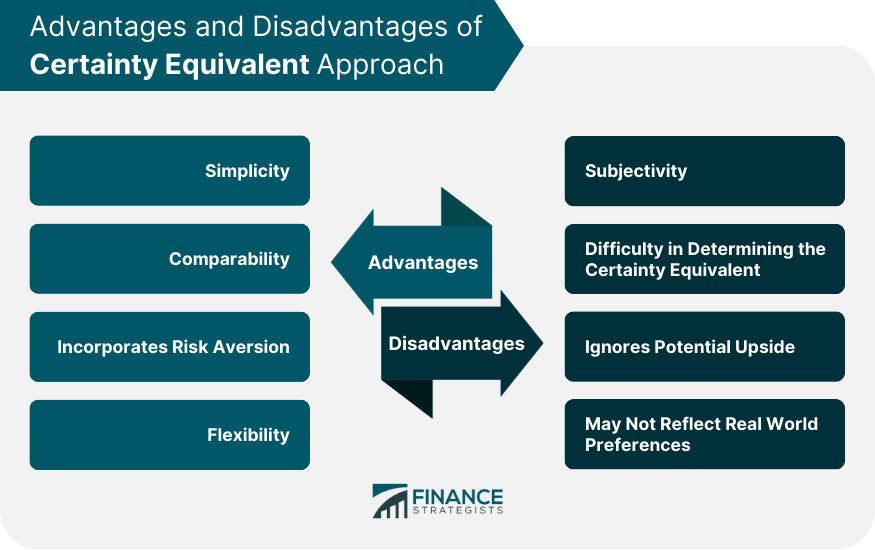The Certainty Equivalent is a key concept in finance representing a guaranteed cash amount that an individual or entity would accept today instead of a potentially risky or uncertain future cash flow. This model mirrors the tendency of people to prefer sure outcomes over uncertain ones, even if the uncertain outcome might hold a greater potential upside. The primary purpose of the Certainty Equivalent is to provide a tool for quantifying the level of risk an investor is willing to accept, thus serving as a crucial element in financial decision-making. It assists financial managers, investors, and policy makers in areas like investments, capital budgeting, portfolio management, and insurance, offering a systematic approach to comprehend and manage risk associated with various financial transactions. Its application simplifies complex financial scenarios, offering a definitive guide through the labyrinth of risk and uncertainty. The certainty equivalent is rooted in the expected utility theory, a mathematical model used in economics and finance to handle risk and uncertainty. According to this theory, individuals make decisions based on the expected utility of the outcomes rather than their monetary values alone. This means they consider not just the potential returns but also the level of risk associated with those returns. The certainty equivalent is calculated using the formula: In this formula, the expected return is the average return one could expect from an investment, while the risk premium is the additional return required by an investor to take on a higher level of risk. The certainty equivalent coefficient, also known as the risk tolerance or the absolute risk aversion, is another key component in calculating the certainty equivalent. It measures an individual's or entity's degree of risk aversion. A lower coefficient signifies a higher tolerance for risk, while a higher coefficient indicates a lower tolerance for risk. Risk aversion refers to the tendency of individuals or entities to prefer certain outcomes over uncertain ones, even if the expected return of the uncertain outcome is higher. This concept is fundamental in finance, affecting decisions about investments, portfolio management, and more. The certainty equivalent and risk aversion are intimately connected. A higher level of risk aversion leads to a lower certainty equivalent, meaning that a risk-averse individual or entity would require a higher guaranteed return today to accept a risky or uncertain future cash flow. Various factors influence risk aversion, including an individual's or entity's financial situation, past experiences with risk, tolerance for uncertainty, and even psychological factors. Understanding these factors can help in calculating the certainty equivalent more accurately, leading to better financial decisions. Capital budgeting is the process through which a company decides where and how much to invest in long-term assets, such as new machinery, research, and development, or new products. These decisions are crucial for a company's growth and profitability. The certainty equivalent approach in capital budgeting involves adjusting the future cash flows from a project to reflect their certainty equivalents and then discounting these adjusted cash flows at a risk-free rate. This method allows for a more accurate estimation of a project's net present value (NPV), leading to more informed investment decisions. Portfolio management involves the art and science of making decisions about investment mix and policy, aligning investments to objectives, asset allocation, and balancing risk against performance. The primary goal is to maximize returns while minimizing risk. Certainty equivalent plays a significant role in portfolio management. It aids in the assessment of different investment options, helping to determine the risk-adjusted returns of various portfolios. By calculating the certainty equivalent for each potential investment, a portfolio manager can better understand and quantify the level of risk associated with different portfolios. In insurance, the certainty equivalent concept is essential for determining premiums. Insurers calculate the certainty equivalent of the potential payout they would have to make in the case of an insured event. This calculation helps them set premiums at a level that ensures profitability while still providing adequate coverage to policyholders. In actuarial science, certainty equivalent is used to value uncertain future cash flows, such as those from annuities or insurance policies. The calculation involves adjusting the expected cash flows for the risk they carry, providing a more accurate valuation. The use of certainty equivalent in insurance and actuarial science has significant implications for pricing and risk management. It allows for more accurate pricing of policies and more effective management of risk, ensuring the financial stability and sustainability of insurance companies. Real options analysis is a decision-making tool that helps managers make strategic investment decisions. It views investment opportunities as "real options" — tangible opportunities that a company can choose to pursue or ignore. The certainty equivalent is used in real options analysis to calculate the risk-adjusted value of these options. By determining the certainty equivalent of an investment opportunity, managers can make more informed decisions about whether to pursue it. The use of certainty equivalent in real options analysis can significantly impact investment decisions. By providing a clearer understanding of the risk and potential return of different options, it allows for more strategic and effective decision-making. 1. Simplicity: The Certainty Equivalent Approach is fairly straightforward. It requires the calculation of a single value, which represents the certain return an investor would accept instead of taking a risk. 2. Comparability: It allows comparison between different risky prospects by converting them into their certainty equivalents. This simplifies the decision-making process. 3. Incorporates Risk Aversion: It takes into account an investor's risk aversion, which is a critical factor in investment decision-making. Different individuals have different levels of risk tolerance, and the certainty equivalent approach can reflect this in its assessments. 4. Flexibility: It can be applied to various types of cash flows, including single-period or multi-period, and to different types of investments. 1. Subjectivity: The approach relies on the individual's perception of risk, which can be highly subjective. Two different investors might have two very different certainty equivalent values for the same risky prospect. 2. Difficulty in Determining the Certainty Equivalent: It can be challenging to determine the certainty equivalent, especially for complex investments. This might require sophisticated models and assumptions. 3. Ignore Potential Upside: The approach might cause an investor to overlook potentially profitable investments because it focuses on the certain equivalent rather than the potential for high returns. 4. May Not Reflect Real World Preferences: In reality, people's preferences and attitudes toward risk can change over time and may not be consistent. The certainty equivalent approach assumes a constant level of risk aversion, which may not always be accurate. While the certainty equivalent is a valuable tool in finance, it is not without its criticisms. Some argue that it oversimplifies the complexities of risk and uncertainty, while others believe that it relies too heavily on subjective assessments of risk aversion. The certainty equivalent may not always provide an accurate measure of risk and return in different financial contexts. For example, in situations of extreme uncertainty or volatility, the certainty equivalent may not fully capture the risk associated with an investment. In response to these limitations, various alternative models and approaches have been developed. These include stochastic modeling, Monte Carlo simulations, and other advanced mathematical techniques that aim to provide a more comprehensive view of risk and return. The Certainty Equivalent is a crucial financial concept that quantifies the risk investors are willing to accept, providing a reliable foundation for financial decision-making. The mathematical concept of Certainty Equivalent is deeply rooted in Expected Utility Theory. Its calculation factors in the Expected Return and Risk Premium of an investment. The Certainty Equivalent approach simplifies comparisons between risky prospects, considering the investor's risk aversion, and is applicable across varied cash flows. However, its subjective nature and potential to overlook profitable investments are shortcomings. Understanding the Certainty Equivalent can enhance decision-making in capital budgeting, portfolio management, insurance, actuarial science, and real options analysis. Despite its benefits, critics argue it simplifies complex risk scenarios and leans heavily on subjective risk aversion assessments. Consequently, alternatives like stochastic modeling and Monte Carlo simulations are also used to account for uncertainties in financial contexts.What Is Certainty Equivalent?
Mathematical Concept of Certainty Equivalent
Expected Utility Theory
Calculating the Certainty Equivalent

Certainty Equivalent Coefficient
Certainty Equivalent and Risk Aversion
Relationship Between Certainty Equivalent and Risk Aversion
Factors Affecting Risk Aversion
Certainty Equivalent in Capital Budgeting
Concept of Capital Budgeting
Certainty Equivalent Approach in Capital Budgeting
Certainty Equivalent in Portfolio Management
Basic Principles of Portfolio Management
Application of Certainty Equivalent in Portfolio Management
Certainty Equivalent in Insurance and Actuarial Science
Role of Certainty Equivalent in Insurance
Certainty Equivalent in Actuarial Science
Implication for Pricing and Risk Management
Certainty Equivalent in Real Options Analysis
Understanding Real Options Analysis
Application of Certainty Equivalent in Real Options Analysis
Impact on Investment Decisions

Advantages of Certainty Equivalent Approach
Disadvantages of Certainty Equivalent Approach

Criticisms and Limitations of Certainty Equivalent
Common Criticisms of Certainty Equivalent
Limitations in Different Financial Contexts
Alternative Models and Approaches
Final Thoughts
Certainty Equivalent FAQs
Certainty equivalent is the guaranteed amount of cash that a person would accept today instead of a risky or uncertain cash flow in the future.
The certainty equivalent is calculated by dividing the expected return by one plus the risk premium.
The certainty equivalent plays a crucial role in various areas of finance, including capital budgeting, portfolio management, insurance, and actuarial science.
A higher level of risk aversion leads to a lower certainty equivalent. This means a risk-averse person would require a higher guaranteed return today to accept a risky future cash flow.
Criticisms of the certainty equivalent concept include oversimplification of risk and reliance on subjective assessments of risk aversion.
True Tamplin is a published author, public speaker, CEO of UpDigital, and founder of Finance Strategists.
True is a Certified Educator in Personal Finance (CEPF®), author of The Handy Financial Ratios Guide, a member of the Society for Advancing Business Editing and Writing, contributes to his financial education site, Finance Strategists, and has spoken to various financial communities such as the CFA Institute, as well as university students like his Alma mater, Biola University, where he received a bachelor of science in business and data analytics.
To learn more about True, visit his personal website or view his author profiles on Amazon, Nasdaq and Forbes.















